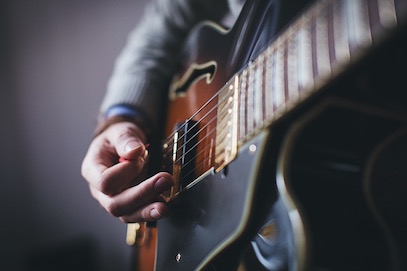
Arpeggio On Guitar
Hold any chord shape in your fretting hand, and then pick the notes individually rather than strumming. Do this, and you are playing an arpeggio. How to play an Arpeggio On Guitar is something all guitarists will come across as they improve their skills.
An Arpeggio is picking the notes of a chord individually rather than sounding all of the notes at the same time.
You can take the concept further by looking at different picking techniques and also see how chord arpeggios relate to scales.
The follow up question to How Do You Play Arpeggios on Guitar, is Why Do You Use Arpeggios.
Arpeggios add color and interest to your performance. You might want to play Verse 1 strumming the chords, and then follow that by playing Verse 2 using an arpeggio style of rhythm.
They are also great for use in solos. When combined with scales or licks, they enhance any solo.
Arpeggios
- Know What An Arpeggio Is
- Which Arpeggio To Start With
- How To Practice Arpeggios
- How Do Arpeggios Work With Scales
- Have a Good Chord Library
- What Is The Grand Arpeggio
What Is An Arpeggio
We covered the answer to “What Is An Arpeggio,” in the first couple of paragraphs in this article. However, here is the same information slightly re-stated. The word arpeggio (ar-peh-jee-oh) comes from the Italian word arpeggiate. It means, “to play a harp.” Notes of a chord are played individually rather than being strummed together.
G Chord

G Chord Arpeggio using the “C shaped” barre chord

Which Arpeggio To Start With
Any Chord Shape can be turned into an arpeggio. Even so, when starting off it would be a good idea to get a grasp on the fundamental chord shapes of A, C, D, E, and G. If you are familiar with the CAGED System, you will notice that these are some of the same chords that make up the building blocks of that system of visualizing the guitar neck as well.
Learn by drilling the chord shapes until they are comfortable. I recommend that you use the Barre Chord Shapes for each of these.





How to Practice Playing an Arpeggio
Practice holding the chord shape and pick each string individually.
Once you are comfortable with that, then practice playing all of the notes in the chord but don’t hold the chord shape. In other words, fret each note as you play it. That is how a lead player might work an arpeggio into a solo line. The notes are picked individually without one note sustaining into the next.

How Do Arpeggios Work With Scales
Arpeggios are chords where the notes of the chord are played individually rather than sounded all at once. So, the question “How Do Arpeggios Work With Scales,” is really the same as asking how do chords work with scales.
Here is where it helps if you understand some music theory. In other words, knowing how a chord is built, and also knowing how a scale is built, will give you the answer to which chords and scales work well together.
A better answer would be that knowing the structure of how both chords and scales are built, will let you know how the notes of the arpeggio function within the scale. Will the notes be dissonant, will they be warm, pretty, solid, or however you want to define it.
This can all be discovered by using your ear as well, but having some theoretical knowledge will give you an anchor to attach each sound to. For example, you will know that the sound that you are listening to is a flat 2 even though the scale might not have that interval in it.
Remember, music came first and music theory came second. Therefore, the scales were established before someone came along and came up with a system to explain the relationship of one note to the next.
Even so, once a system (Music Theory) was established to explain the relationship of one note to the next, we could then see where some of the similarities were between notes, scales, and chords.
For example: An A minor Pentatonic Scale is built with the intervals 1, b3, 4, 5, b7
The Am7 chord is built with the intervals 1, b3, 5, b7
In other words, the A minor Pentatonic scale and the Am7 chord share the same 4 out of 5 notes.
Therefore, the Am7 chord works well with the A minor Pentatonic Scale.

Have a Good Chord Library
If you want the option to have access to numerous chord arpeggios, you can do a few things.
- You could have a book or poster full of chord shapes
- You could have an incredible memory and memorize 1000’s of chords
- You can wait until they figure out how to plug your brain into the internet where you will have access to a library of chords (not recommended)
- You could learn a few simple formulas and know how chords an scales are built (Music Theory Course. JSIGuitar.com)
What Is The Grand Arpeggio
A grand arpeggio is a neat way of playing all of the notes in a diatonic scale. Start on any note of the scale, and then play every other note in that scale.
